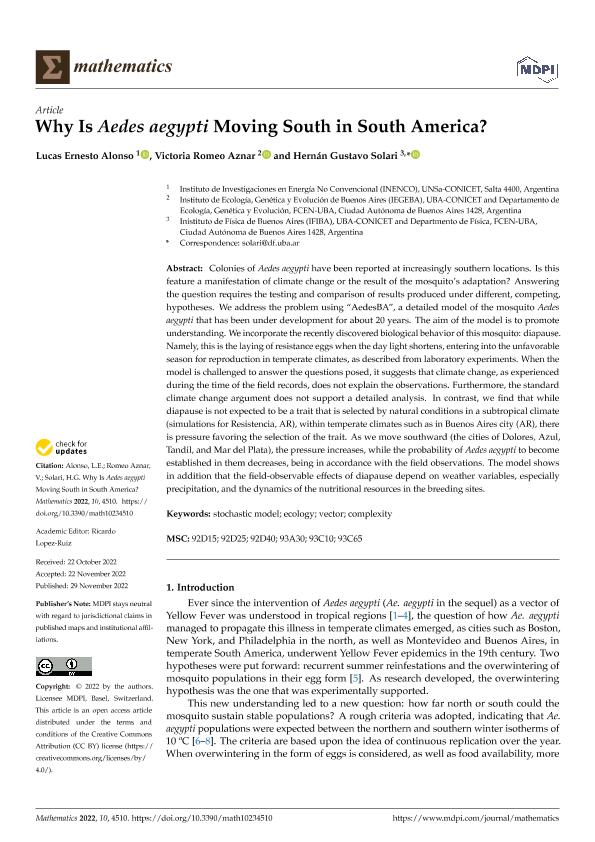Artículo
Why Is Aedes aegypti Moving South in South America?
Fecha de publicación:
12/2022
Editorial:
MDPI
Revista:
Mathematics
ISSN:
2227-7390
Idioma:
Inglés
Tipo de recurso:
Artículo publicado
Clasificación temática:
Resumen
Colonies of Aedes aegypti have been reported at increasingly southern locations. Is this feature a manifestation of climate change or the result of the mosquito’s adaptation? Answering the question requires the testing and comparison of results produced under different, competing, hypotheses. We address the problem using “AedesBA”, a detailed model of the mosquito Aedes aegypti that has been under development for about 20 years. The aim of the model is to promote understanding. We incorporate the recently discovered biological behavior of this mosquito: diapause. Namely, this is the laying of resistance eggs when the day light shortens, entering into the unfavorable season for reproduction in temperate climates, as described from laboratory experiments. When the model is challenged to answer the questions posed, it suggests that climate change, as experienced during the time of the field records, does not explain the observations. Furthermore, the standard climate change argument does not support a detailed analysis. In contrast, we find that while diapause is not expected to be a trait that is selected by natural conditions in a subtropical climate (simulations for Resistencia, AR), within temperate climates such as in Buenos Aires city (AR), there is pressure favoring the selection of the trait. As we move southward (the cities of Dolores, Azul, Tandil, and Mar del Plata), the pressure increases, while the probability of Aedes aegypti to become established in them decreases, being in accordance with the field observations. The model shows in addition that the field-observable effects of diapause depend on weather variables, especially precipitation, and the dynamics of the nutritional resources in the breeding sites.
Palabras clave:
COMPLEXITY
,
ECOLOGY
,
STOCHASTIC MODEL
,
VECTOR
Archivos asociados
Licencia
Identificadores
Colecciones
Articulos(IEGEBA)
Articulos de INSTITUTO DE ECOLOGIA, GENETICA Y EVOLUCION DE BS. AS
Articulos de INSTITUTO DE ECOLOGIA, GENETICA Y EVOLUCION DE BS. AS
Articulos(IFIBA)
Articulos de INST.DE FISICA DE BUENOS AIRES
Articulos de INST.DE FISICA DE BUENOS AIRES
Articulos(INENCO)
Articulos de INST.DE INVEST.EN ENERGIA NO CONVENCIONAL
Articulos de INST.DE INVEST.EN ENERGIA NO CONVENCIONAL
Citación
Alonso, Lucas Ernesto; Romeo Aznar, Victoria Teresa; Solari, Hernan Gustavo; Why Is Aedes aegypti Moving South in South America?; MDPI; Mathematics; 10; 23; 12-2022; 1-22
Compartir
Altmétricas




